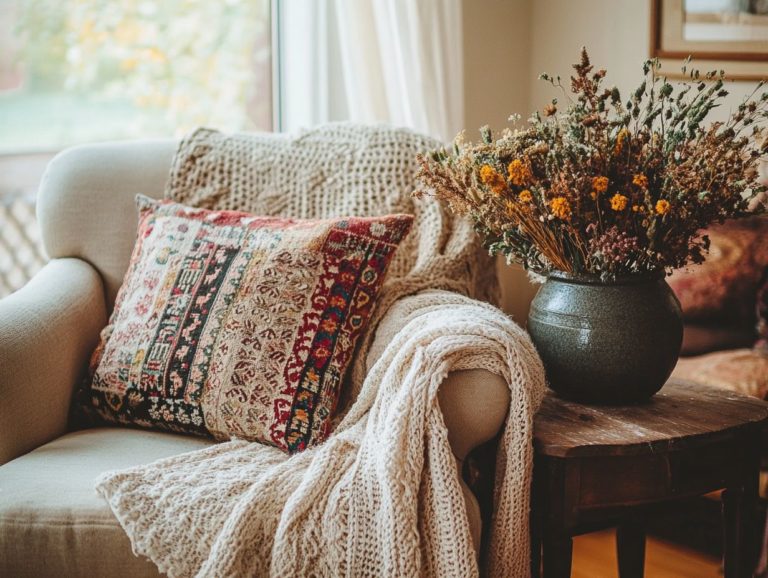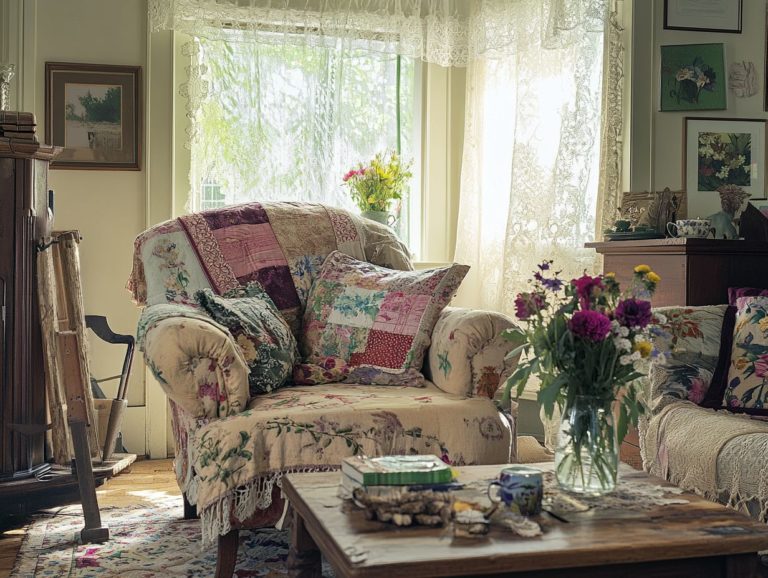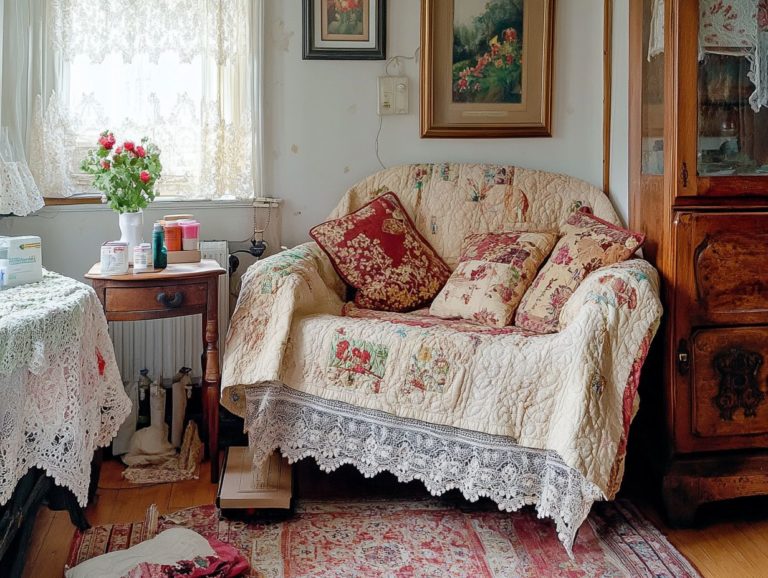What Is the Role of Vintage Decor in Sustainable Design?
Sustainable design is more than a trend; it s an essential evolution that protects our planet and respects cultural heritage.
Vintage decor stands at the forefront of this movement, providing a distinctive means to minimize waste while paying homage to history.
In this article, you ll explore sustainable design’s essence. You’ll learn how to integrate vintage pieces and discover practical tips for incorporating them into your home.
Get inspired! Repurposing vintage finds and choosing eco-friendly materials can transform your space and contribute to a more sustainable future.
Join in as you discover the increasingly significant influence of vintage decor on the design industry.
Contents
- Key Takeaways:
- The Concept of Sustainable Design
- The Importance of Vintage Decor in Sustainable Design
- Reducing Waste and Environmental Impact
- Preserving History and Culture
- Incorporating Vintage Decor in Interior Design
- Tips for Finding and Incorporating Vintage Pieces
- Sustainable Practices in Vintage Decor
- The Future of Vintage Decor in Sustainable Design
- Frequently Asked Questions
- What is the role of vintage decor in sustainable design?
- How does vintage decor promote sustainability?
- What are some examples of vintage decor in sustainable design?
- How does incorporating vintage decor support ethical and eco-friendly practices?
- What are the benefits of using vintage decor in sustainable design?
- Can vintage decor fit into modern and contemporary design?
Key Takeaways:

- Vintage decor is not just a trend; it s a game-changer for sustainable design!
- By repurposing and upcycling vintage pieces, designers can create unique and environmentally-friendly spaces.
- The growing interest in vintage decor has the potential to greatly impact the design industry and promote more sustainable practices in the future.
The Concept of Sustainable Design
Sustainable design embodies the essence of environmentalism and responsible craftsmanship. It aims to craft interior spaces that minimize negative environmental impacts while maximizing comfort, beauty, and enduring appeal.
This approach seamlessly integrates eco-friendly practices and high-quality materials, significantly reducing carbon emissions and waste.
It champions a circular economy, which means reusing materials instead of making new ones, helping reduce waste.
By emphasizing individual expression and unique character, sustainable design resonates with today s values of nostalgia, comfort, and aesthetics. It strikes a harmonious balance between contemporary living and our ecological footprint.
Defining Sustainability in Design
Sustainability in design means crafting products and spaces that fulfill your current needs without jeopardizing the ability of future generations to meet theirs. It emphasizes the use of eco-friendly materials and practices.
This concept goes beyond aesthetics. Every element be it furniture, finishes, lighting, or layouts is meticulously evaluated for its environmental impact.
You ll notice designers increasingly turning to sustainable materials like bamboo, reclaimed wood, and low-VOC paints. They aim to cut down on waste and minimize harmful emissions.
Innovative processes, such as energy-efficient manufacturing and waste reduction strategies, are crucial to this movement.
Ultimately, embracing the philosophy of sustainability in interior design elevates the aesthetic appeal of your spaces while cultivating an environment that works in harmony with nature, promoting a healthier planet for generations to come.
The Importance of Vintage Decor in Sustainable Design
Vintage decor is crucial, providing unique character and a sense of nostalgia. This allows you to express your individuality while minimizing your environmental impact through responsible consumption.
By incorporating vintage-inspired pieces and heirloom home decor, you embrace timeless aesthetics and champion craftsmanship while reducing waste.
Vintage furniture and textiles often come with rich stories and histories. These deepen the connection between you and your surroundings, fostering a sustainable lifestyle that reflects a commitment to preserving the past.
Reducing Waste and Environmental Impact
Incorporating vintage decor significantly reduces waste and environmental impact by promoting the reuse of materials. It helps you avoid the allure of fast design and mass production.
Each vintage piece has its own unique story. This approach champions a system that reuses items to save resources. Consider this: the production of new furniture accounts for 8% of global greenhouse gas emissions. This statistic highlights the immediate need for more sustainable choices.
When you choose vintage options, you join a movement that values sustainability over fleeting trends. You make choices that help protect the environment. Numerous case studies show that vintage items require fewer resources to maintain and restore, illustrating how thoughtful design choices can be pivotal for waste reduction.
Preserving History and Culture

Preserving history and culture through vintage decor elevates your interior design. It offers a tangible connection to the past while showcasing exquisite craftsmanship.
These items, rich with narratives, serve as more than mere decorations. They become conversation starters that bridge generations and illuminate the artistry of different eras.
For many, incorporating vintage elements is a profound form of personal expression. By choosing pieces that resonate with your experiences or aesthetics, you create spaces that reflect your identity. You also honor the craftsmanship of the artisans who came before you.
This blend of history and individuality in design fosters a deeper appreciation for the artistry inherent in cultural artifacts.
Incorporating Vintage Decor in Interior Design
Incorporating vintage decor into your interior design opens the door to creative expression. This approach creates spaces that captivate the eye and spark joy.
Imagine using vintage furniture, botanical wallpapers, and striking antiques. These elements evoke nostalgia and add a unique flair to your environment. By thoughtfully integrating these vintage-inspired elements, you can craft cohesive atmospheres that resonate with both comfort and beauty. This is all while championing sustainable living through the use of high-quality materials. Discover more about what makes vintage decor unique and special.
Tips for Finding and Incorporating Vintage Pieces
Finding and incorporating vintage pieces into your home is an exhilarating journey. It enhances your interior spaces and promotes sustainable design practices.
This adventure often starts by exploring online platforms like Chairish and 1stDibs. Here, you’ll find a stunning array of vintage furnishings from various eras. As you browse these sites, you’ll discover unique finds unavailable in mainstream stores. Plus, you support small businesses and individual sellers.
Don’t overlook local vintage shops. Venturing into these hidden gems can lead to unexpected treasures. You can physically assess items for quality and character. When sourcing these beauties, keep restoration techniques in mind. A simple refinishing or reupholstering can breathe new life into a worn piece.
Ultimately, the charm and history in vintage furnishings create a space that feels both timeless and distinctly personal.
Sustainable Practices in Vintage Decor
Sustainable practices in vintage decor focus on repurposing, restoration, and using eco-friendly materials. This approach reduces waste and lessens environmental impact. By reusing old items to create something new, you can curate stylish interior spaces that are also mindful of your ecological footprint.
This approach celebrates quality craftsmanship while aligning with the principles of sustainable living. It enables you to create unique, character-filled designs that truly embody timelessness.
Repurposing and Upcycling
Repurposing and upcycling vintage decor extends the life cycle of your furniture and decorative elements. It plays a pivotal role in sustainability and waste reduction.
Transform outdated pieces into functional art. This not only minimizes your environmental footprint but also showcases your creativity. For instance, turning an old wooden door into a rustic coffee table creates a unique centerpiece for your space and prevents waste from ending up in landfills.
Similarly, reimagining glass jars as chic lighting fixtures highlights the beauty of reusing materials and reduces the need for new resources.
These fun projects not only beautify your home but also let your creativity shine! They foster a culture of sustainability, encouraging others to explore the positive impact of thoughtful buying and creative recycling.
Choosing Eco-Friendly Materials

Choosing eco-friendly materials for your vintage decor elevates sustainability in any design project. It celebrates craftsmanship while minimizing the ecological footprint of your interior spaces.
Incorporate materials like reclaimed wood, bamboo, or sustainably sourced fabrics. These choices craft a distinctive aesthetic and champion responsible practices that honor the planet.
When you utilize reclaimed wood from old structures, you infuse character into your furniture. This keeps waste out of landfills a beautiful blend of style and sustainability.
Opting for organic cotton or linen in your upholstery creates a healthier home environment by reducing exposure to harmful chemicals. These choices reflect a growing trend toward eco-conscious design that values both craftsmanship and environmental stewardship.
The Future of Vintage Decor in Sustainable Design
The future of vintage decor in sustainable design presents remarkable opportunities. You and your peers millennials place a higher value on sustainability and eco-friendly choices in your purchasing decisions.
This generational shift toward appreciating craftsmanship and unique character allows vintage decor to thrive. It highlights emotional connections and stories over the blandness of mass production.
Embrace the circular economy. Understanding what makes vintage decor timeless will undoubtedly highlight its importance in minimizing environmental impact while allowing for personal expression in your living spaces.
Growing Interest and Impact on Design Industry
The rising fascination with vintage decor is making waves in the design industry. Like many millennials, you seek out sustainable and eco-friendly options that align with your values. This shift towards vintage reflects a broader trend where individuals prioritize unique, story-rich pieces over mass-produced alternatives.
As vintage items become more accessible through online platforms and thrift stores, you ll find diverse choices that cater to your personal aesthetics and commitment to ethical consumption.
The revival of retro styles shapes your purchasing decisions and inspires designers to weave timeless elements into modern creations. With sustainability at the forefront, you re likely starting to see second-hand items as valuable contributions to a greener lifestyle.
This effectively reshapes market demand and consumer behavior in the home decor realm.
Frequently Asked Questions
What is the role of vintage decor in sustainable design?
Vintage decor plays a crucial role in sustainable design by reducing the need for new materials and promoting a circular economy.
How does vintage decor promote sustainability?

Using vintage decor reduces the need for new materials. This conserves natural resources and cuts down on waste in landfills.
What are some examples of vintage decor in sustainable design?
Examples of vintage decor in sustainable design include repurposed furniture, reclaimed wood, and upcycled home accessories.
How does incorporating vintage decor support ethical and eco-friendly practices?
Using vintage decor supports ethical and eco-friendly practices. It reduces the environmental impact of creating new materials and helps protect workers from exploitation.
What are the benefits of using vintage decor in sustainable design?
Vintage decor enhances sustainability and adds unique character to your space. It often costs less than buying new items.
Can vintage decor fit into modern and contemporary design?
Yes! Vintage decor brings charm and contrast to modern designs. It can serve as a statement piece, adding history and depth to any room.






